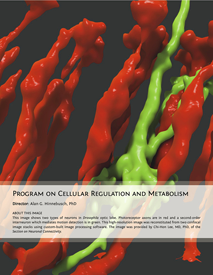You are here: Home > Program in Cellular Regulation and Metabolism
Program in Cellular Regulation and Metabolism
Director: Alan G. Hinnebusch, PhD
The seven investigators in this program, all belonging to the Laboratory of Gene Regulation and Development (LGRD), apply a combination of genetics, biochemistry, cell biology, and structural biology to elucidate the molecular basis of processes fundamentally important in cell biology or animal development. Three of the seven groups study molecular mechanisms of transcriptional and translational control of gene expression and the transposition of retroelements in budding or fission yeast. Two groups employ the fruit fly Drosophila to investigate molecular mechanisms in development, including the molecular basis of neuronal connection specificity in the visual system, receptor clustering at synapses of the neuromuscular junction, and cell signaling by TGF-beta factors. The aneuran Xenopus laevis serves as a model system for the work of the remaining two groups, one of which focuses on spindle assembly and chromosome segregation and the other on transcriptional programming of adult stem cells in organ development during metamorphosis.
Members of the Section on Nutrient Control of Gene Expression, headed by Alan Hinnebusch, study mechanisms of transcriptional and translational gene regulation. Recently, they provided evidence that the essential function of the beta subunit of the 5-subunit guanine nucleotide exchange factor eIF2B is to promote binding of the substrate, GDP–bound translation initiation factor 2 (eIF2), for the recycling of eIF2. They also demonstrated that interaction of the poly(A) binding protein (PABP) with eIF4G is dispensable for translation in the presence of the N-terminal RNA–binding domain in eIF4G, implying that mRNA circularization via cap-poly(A) interaction is not fundamentally important in vivo but rather represents only one of several interactions that stabilize eIF4G binding to mRNA. Furthermore, genome-wide analysis revealed that eIF4G is dispensable for the translation of most mRNAs, functioning primarily to boost translation rates several fold. It also plays a modest role in adjusting relative translational efficiencies of mRNAs across the genome.
The Section on Cell Cycle Regulation, headed by Mary Dasso, studies mechanisms that assure accurate chromosome segregation in metazoan cells. The group recently showed that the SUMO pathway for covalent protein modification plays an essential role in the assembly of kinetochores, the proteinaceous structures that attach sister chromatids to mitotic spindles. Members of the group demonstrated that proteins of the nuclear pore complex and Ran GTPase pathway are essential for the robust formation of the microtubule fibers that link kinetochores to mitotic spindles and mediate the segregation of chromosomes into daughter cells at anaphase.
The Section on Protein Biosynthesis, headed by Thomas Dever, is characterizing the structure and function of several translation initiation factors and the molecular principles of kinase-substrate recognition by the stress-responsive eIF2a kinases. The group recently identified eIF2 contacts with the ribosome and revealed an unexpected structure of the eIF2–Met-tRNAiMet ternary complex. The group also reported that binding of the kinase domain of the eIF2a kinase PKR induces a conformational change in its substrate, eIF2a, to expose the phosphorylation site and thus restrict translational regulation via eIF2a phosphorylation to the family of eIF2a kinases. Members of the group also demonstrated that the hypusine-containing protein eIF5A promotes translation elongation.
Henry Levin heads the Section on Eukaryotic Transposable Elements, which analyzes LTR retrotransposons and the integration of their cDNA into the chromosomes of host cells. Recently, the laboratory adapted methods of deep sequencing to determine the positions of retrotransposon Tf1 integration throughout the genome of Schizosaccharomyces pombe. The data obtained provided a reproducible and saturating profile of integration activity for each intergenic sequence and gene-coding sequence. In other studies, the laboratory adapted the Hermes transposon from the housefly to generate maps, of unprecedented density, of integration in S. pombe. The profiles identify a comprehensive set of essential genes, but it is notable that nonessential genes important for robust cell growth are also identified by their intermediate levels of insertion.
The Section on Neuronal Connectivity, headed by Chi-Hon Lee, investigates the development and function of visual circuits in Drosophila. Using novel imaging techniques, his group characterized dendritic patterns of optic lobe neurons and derived type-specific attributes. The group revealed that TGF-beta/Activin signaling regulates the development of dendritic branches. To investigate visual information processing, the group developed a single-cell transcript profiling technique for determining the usage of neurotransmitters and receptors in optic lobe neurons.
The Unit on Cellular Communication, headed by Mihaela Serpe, investigates molecular mechanisms that regulate cellular signaling during development, employng the Drosophila system. The group's studies on early embryonic patterning showed how evolutionary changes in proteolytic destruction of the BMP-binding protein Sog by Tolloid/BMP-1 have influenced morphogen gradient formation and function in the Drosophila embryo. The group recently identified a neuropillin and tolloid-like protein, Neto, as a component essential for clustering the ionotropic glutamate receptors at the Drosophila neuromuscular junction.
The Section on Molecular Morphogenesis, headed by Yun-Bo Shi, studies the gene-regulatory mechanisms controlled by thyroid hormone receptor (TR) that establish the metamorphosis program in Xenopus laevis. The group discovered that adult intestinal stem-cell formation requires both cell-autonomous function of TR and cell-cell interactions induced by TR and thus also revealed an evolutionally conserved role of the TR coactivator PRMT1 in adult stem-cell development in vertebrate intestine.


